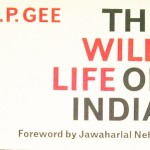The End of A Trail: The Cheetah in India
By Divyabhanusinh
As the title of the book The End of A Trail: The Cheetah in India suggests, one gets to know the complete history of the Cheetah starting from the chronicles of the Mughals to the modern day records from various sources till it got extinct. This book also collects information about the cheetah from the middle east to Iran, Iraq as well as parts of the former Soviet republics.
This book is replete with old photographs as well as art works from the Moghul era painstakingly sourced from various museums abroad, which not only tells us the story of the Cheetah along with the wildlife of that bygone era but also educates us about our history. The author writes that Moghul Emperor Akbar’s reluctance to read and write resulted in hispainters making detailed paintings for him and hence we have some authentic records about Cheetahs through the art works commissioned during his era. The author examines the various records of Cheetah in Sanskrit including the etymology of the name.
The book also delves into the imported African Cheetahs brought into India by the kings of various provinces for coursing when the Indian Cheetah had become relatively rare. Simple case of Swadeshi giving way to Videshi is a compelling story even about wildlife imports. When you dont care to become self-sustaining, you have to look outwards and import. While discussing the cost of African Cheetah, one also is reminded about the value of the Indian rupees in those days. In 1940, the US dollar was worth 3.31 rupees. Today the rupee is twenty times cheaper, a stark reminder of the nosedive that Indias economy has taken since then. These two information is perhaps a telling commentary of not only our economy but the contempt with which we practice sustainability. That is the story of imports of other goods to India as well in the later years.
This book opened my eyes about the prevalent practices of training other carnivores for hunting blackbucks and other herbivores. Caracal, a rarely seen carnivore, was also trained to hunt. The trainers were careful about the caracal as it can also attack its handler by biting and holding onto the neck, which the cheetah wont. Reading the training methods adopted gives us an idea about the deep knowledge of animal behaviour these trainers had. Wish our generation could have such grasp of natural history.
This book also highlights the cruel practice adopted by the British of hunting cheetahs by chasing them over horseback and spearing them. A student of Indias Natural History will also love the quote of Lord Curzon, the Viceroy during the early 19th Century. Lord Curzon in his letter to the Burma Game Preservation Association wrote The causes of this diminution in the wild fauna of India are the steady increase of population, the widening area of cultivation, and the improvement in the means of communication all of them the sequel of what is popularly termed progress in civilisation.
There are some persons who doubt or dispute the progressive diminution of wildlife in India. I think that they are wrong. The facts seem to me to point entirely in the opposite direction. Upto the time of the Mutiny lions were shot in Central India. They are now confined to an ever narrowing patch of forest in Kathiawar. I was on the verge of contributing to their still further reduction a year ago [1900] myself: but fortunately I found out my mistake in time, and was able to adopt a restraint which I hope that others will follow. Except in Native States, the Terai, and forest reserves, tigers are undoubtedly diminishing. This is perhaps not an unmixed evil. The rhino is all but exterminated save in Assam. Bison are not so numerous or so easy to obtain as they once were. Elephants have already had to be protected in many parts. Above all deer Every mans hand appears to be against them, and each year thins the herds. Finally many beautiful and innocent varieties of birds are pursued for the sake of their plumage, which is required to minister to the heedless vanity of Europeon fashion.
Some of the information presented in this book, especially about the status of cheetahs in Iran may look dated as this book was first published in 1995. However, the number of Asiatic Cheetahs in Iran is less and they are still leading a precarious existence there.
In the chapter on Extinction and Reintroduction, Dr. Divyabhanusinh makes a strong pitch for reintroduction of the Asiatic cheetah. The preservation of fauna and flora is more important than the preservation of any of the great monuments, which after all were fashioned by man and can be recreated at a price. The present generation owes it to its successors to restore the only species of a large mammal lost in the plains of India in historical times. Failure to do so would not be forgiven by the judgement of history.
There was ofcourse an attempt made, albeit muddleheaded, to reintroduce the cheetah in India in 2009. Because of the low cheetah numbers in Iran, relocating a few cheetahs from Iran is likely to reduce the gene pool. On this pretext there was a controversial move to introduce African Cheetahs in India. Thankfully, that ridiculous proposal of introducing an alien species, was nixed by the Honbe Supreme Court of India in 2012. For the record, there has been an agreement between Iran and Russia in 2010 to introduce some Asiatic Cheetahs (Acinonyx jubatus venaticus) in their former habitat in the Northern Caucasus region of Russia.
The book has great value for reference purposes as there are many tables including one, which talks about the Chronology of Extinction and gives us an idea about the cheetahs from various parts of the country. This book has as much appeal to the wildlife enthusiast as it has to a researcher or for that matter to a student of history and hence this effort to bring it again infront of a new generation of readers, researchers and wildlife enthusiasts.
Published by Oxford University Press, this 248 page book is priced at Rs.795/- and is turning out to be a collectors item.
- GoPro Hero 12 Black - 6 September,2023
- Leopards: The Last Stand - 2 July,2023
- Drifting in the Waters of Sundarbans - 26 March,2023














Need pics of 3-4 pages at the end. Friend is writing an article on Cheetahs. Can’t find the book anywhere online. Can you help ?